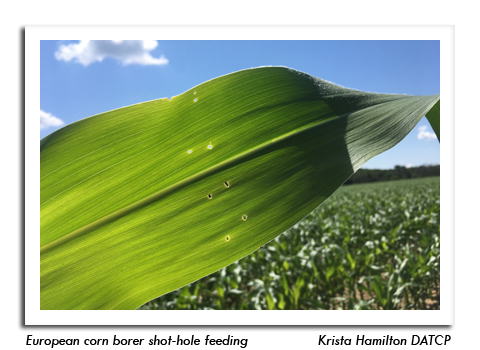
 |
|
|
Corn
Volume 63 Number 9 Date 06/28/2018 EUROPEAN CORN BORER - Early whorl feeding was observed in 20% of the V9-V12 fields sampled this week. Infestations were light, affecting no more than 6% of the plants field-wide. Larvae varied in development from first to third-instar and a few had begun boring into the midribs of corn leaves. The treatment window is expected to close June 29 in the south-central and southwestern counties and will remain open only until about July 8 in the southeastern and central areas. Scouting and management decisions made in the week ahead will be most effective against first-generation corn borers. WESTERN BEAN CUTWORM - Moth emergence continued at very low levels for a second consecutive week. The DATCP network of 54 pheromone traps captured only two moths during the period of June 21-27 and a cumulative total of six moths to date, which is far lower than the 38 moths collected by the same time last year. The appearance of western bean cutworm adults indicates that the annual flight is beginning in the southern half of the state and close inspection of corn plants for egg masses and small larvae should start once fields enter the late-whorl and pre-tassel stages. The eggs are deposited on the upper surface of the top 3-4 leaves, often on the flag leaf, and the larvae can be found in developing tassels. The economic threshold for this pest remains at 5% of plants infested for field corn and 4% for processing sweet corn. Insecticide treatments applied at 90-95% tassel emergence are most effective. TRUE ARMYWORM - Conditions are still very favorable for armyworms after the recent rains, and the significant flights of 309 moths registered in the Janesville black light trap in the past two weeks suggests that the second generation of caterpillars should begin emerging soon. Continued inspection of corn and small grains throughout July is recommended. Light larval infestations involving fewer than 10% of the plants were noted in about 8% of cornfields surveyed by DATCP this month. -- Krista Hamilton, DATCP Entomologist 





|
|
|